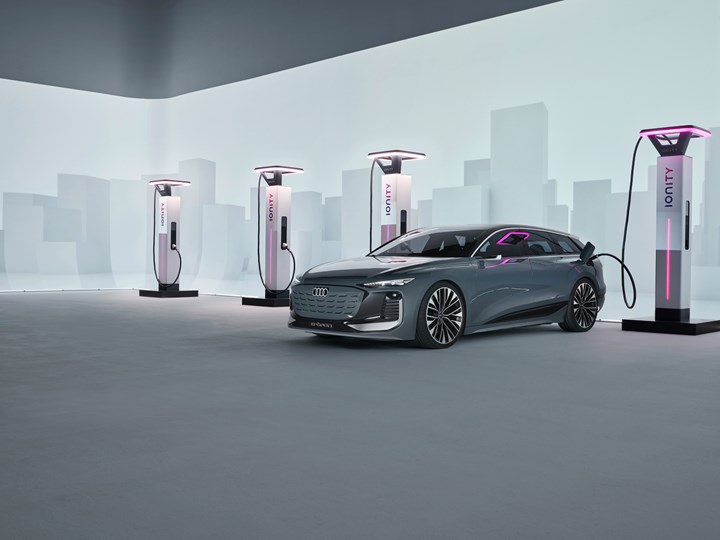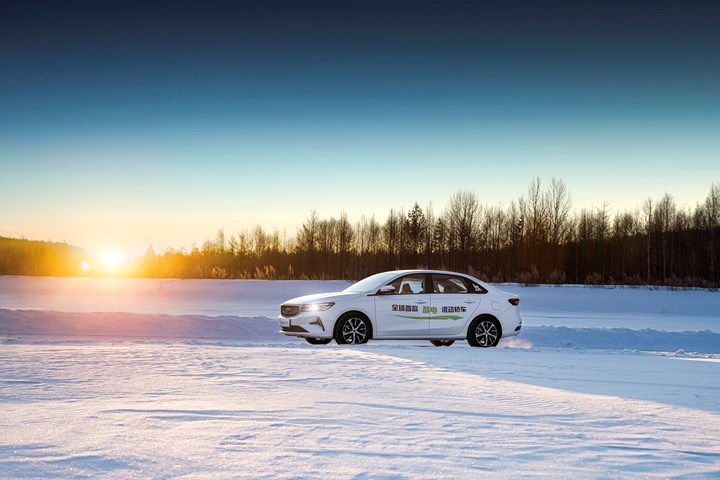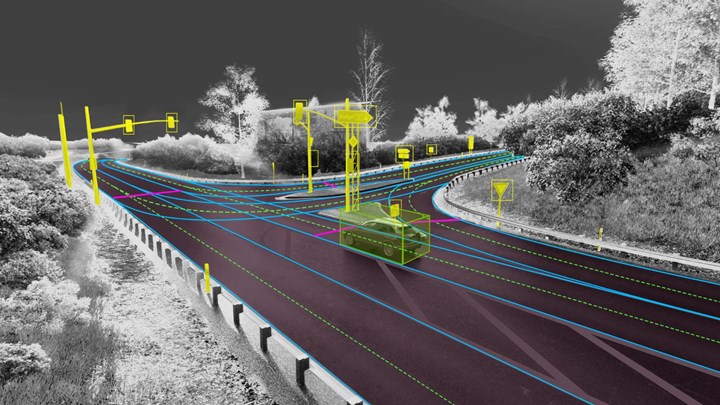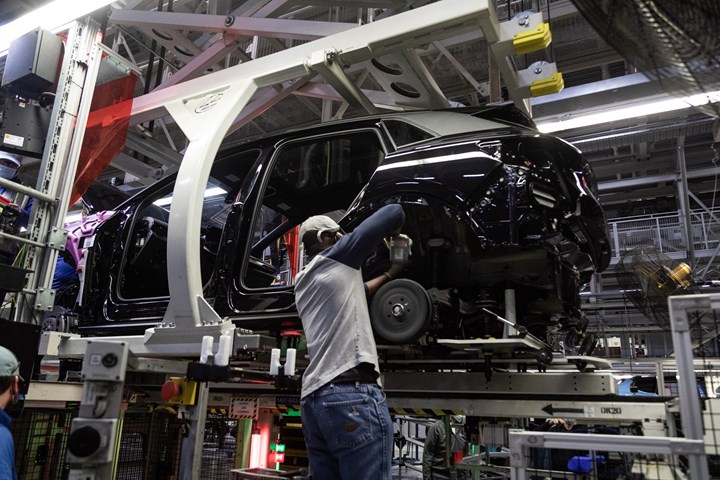on Audi's Future, A-pillar Issues, Methanol & More
Audi is doing well and plans more EVs; why crossing the street can be dangerous; Geely is promoting methanol; vehicles are expensive and some of them take lots of gas at the pump; and how LiDAR can be fooled, which is not a good thing
#electronics
PPE of Another Variety

Audi A6 Avant e-tron concept: stylish. Electric. (Image: Audi)
In its recitation of its 2021 financials—including an operating profit of 5.5 billion euros, an operating return on sales of 10.4% and a cash flow of 7.8 billion euros—Audi Group also pointed out that it did notably well in the delivery of battery electric vehicles: 81,894, or an increase of 57.5% compared with sales in 2020.
And there are EVs more to come.
Audi CEO Markus Duesmann:
“This year, we’ll focus more strongly on the topics of sustainability, electrification and digitalization, and we’ll start the next stage of our transformational course to 2030, which entails the phasing out of combustion technology, a comprehensive roadmap for electromobility and the establishment of new digital business models and services in collaboration with CARIAD, the software unit owned by the VW Group.”
Note well that “phasing out of combustion technology.”
The writing is on the wall for gasoline and diesel engines at Audi and the message says they’re going away. Methodically.
PPE & Audi
One vehicle that got special attention amid the financials is the Audi A6 Avant e-tron concept.
As you can see in the photo above, it is an attractive vehicle.
When it and the other A6 e-trons move from concept to production they will be based on the new Premium Platform Electric (PPE) architecture.
PPE can accommodate B-, C- and D-segment vehicles.
How significant is PPE?
Audi FAW NEV Company, a China joint venture, is building a plant in Changchun scheduled to come on-line late in 2024 that will have an annual capacity of PPE models of 150,000 units.
And while on the subject of China, know that it is Audi’s single-biggest market.
Of the total 1,680,512 vehicles it sold globally in 2021, 701,289 of those were in China.
Europe is the second-biggest, at 617,048, including the sales in Germany (180,883 vehicles).
The U.S.? 196,038.
Here’s a term to know
EVs based on PPE are referred to by Audi as “flat-bottom vehicles.”
Which, if you take the underbody aero execution into account, is spot on.
///
Another Reason to Like Cars (Especially If You Ever Cross a Street on Foot)
“At intersections, the odds that a crash that killed a crossing pedestrian involved a left turn by the vehicle versus no turn were about twice as high for SUVs, nearly 3 times as high for vans and minivans and nearly 4 times as high for pickups as they were for cars. The odds that a crash that killed a crossing pedestrian involved a right turn by the vehicle were also 89 percent higher for pickups and 63 percent higher for SUVs than for cars. Such turning crashes accounted for more than 900 of around 5,800 fatal pedestrian crashes at or near U.S. intersections during 2014-18.”—the Insurance Institute for Highway Safety, March 17, 2022
One possible reason for this, according to IIHS senior transportation engineer Wen Hu:
“It’s possible that the size, shape or location of the A-pillars. . .could make it harder for drivers of these larger vehicles to see crossing pedestrians when they are turning.”
This is an example of a non-virtuous circle: Because the bigger vehicles are heavier, it is necessary to have robust A-pillars for roof-crush protection during rollovers. Unless something like an advanced high-strength steel (AHSS)* is used, the pillar tends to big. Thereby attenuating visibility.
However. . .
It isn’t just crossing a street that can be dangerous.
The study—"The association between pedestrian crash types and passenger vehicle types” by Wen Hu and Jessica B. Cicchino—also found that SUVs and pickups had 51% and 25%, respectively, greater odds than cars of killing people walking or running along the side of a road compared with hitting someone crossing the road and getting hit head-on.
It was found that this is more the case in rural than urban environments, so the percentage of large vehicles in those areas might explain this.
*”Advanced high-strength steels (AHSS) are high-strength (generally greater than 500 MPa) and applied in the body structure, including beams and cross members, sill and pillar reinforcements and other energy-absorbing components.”—"Steel 101: Grades and Repairability” by David W. Anderson, Steel Market Development Institute
///
Not Zero Emissions. But an Alternative

Geely testing a methanol-powered hybrid where it is really, really cold. (Image: Geely)
“Methanol is used in gasoline blends around the world at low (3-5%), mid (15-30%), and high (50-100%) volume percentages,” according to the Methanol Institute.
The organization says of the fuel it favors:
“Methanol (CH3OH) is water-soluble and readily biodegradable, comprising four parts hydrogen, one part oxygen, and one part carbon, and is the simplest member of a group of organic chemicals called alcohols. Methanol is a clean-burning, biodegradable fuel. Increasingly, methanol’s environmental and economic advantages make it an attractive alternative fuel for powering vehicles and ships, cooking food, and heating homes.”
Which brings us to one company that is testing the fuel at a 100% level, Geely.
It recently tested what it describes as “the world’s first methanol hybrid sedan,” an Emgrand sedan.
This wasn’t your run-of-the-mill testing.
It was conducted in -40°C conditions in Heilongjiang province.
Apparently cold starts have been an issue with methanol, but Geely says its “NordThor Power” hybrid tech helps address that.
Powertrain setup
There is a 130-hp 1.8-liter naturally aspirated engine that is connected, by a three-speed hybrid transmission, with a 100-kW electric motor.
The ICE acts as a range extender, only being used to power the wheels under heavy acceleration. (Remember the Chevy Volt? Like that.)
Why do it?
“Clean methanol from green and renewable sources is the most realistic and effective path to reducing emissions and achieving carbon neutrality.”—Eric Li, chairman, Geely Holding Group
Note “realistic” and “effective.” There are a lot of vehicle out there and they all aren’t going to go electric immediately.
Why do it? (2)
Methanol prices at pumps in China equate to about $1.80 USD per gallon.
Why do it? (3)
Geely has invested 3-billion RMB (~$472 million USD) in methanol vehicle development over the past 17 years.
Emissions?
Geely says demonstration trials of a non-hybrid methanol-powered Emgrand had an average well-to-wheel emissions of 46 g of CO2 per kilometer, 70% lower than vehicles burning gasoline. Presumably the hybrid version will be even better.
///
Fun Fact (Unless You’re in the Market)
42.9 weeks.
That’s how many median weeks of income needed to purchase a new vehicle in February, according to the Cox Automotive/Moody’s Analytics Vehicle Affordability Index.
The good news is that while that was up 0.1 weeks from January, it was better than it had been in December, when the amount of time on the job required was a record 43.2 weeks.
And this may be more startling:
The estimated typical monthly payment hit $689.
That’s to handle the $46,085 average transaction price paid.
Good things jobs are plentiful, because there are a lot of weeks to be worked for those wheels.
///
Big Gulp

2022 Ford Expedition. Big. And thirsty. (Image: Ford)
Speaking of spending. . . .
Based on a national average price of $4.27 per gallon of gas, Consumer Reports looked at vehicles its tested and determined the ones that require >$100 to fill from empty
They are, starting with the most expensive to fill to the least (comparatively speaking, because they’re all taking that C-note):
- 2022 Ford Expedition
- 2022 Chevrolet Suburban
- 2022 Toyota Sequoia
- 2022 Nissan Armada
- 2022 Infiniti QX80
- 2022 Nissan Titan
- 2022 Ram 1500
- 2022 Cadillac Escalade
- 2022 Chevrolet Silverado 1500
- 2022 Chevrolet Tahoe
How often the proverbial “pain-at-the-pump”?
All of those vehicles have gas tanks ranging in capacity from 24 to 28 gallons.
The fuel efficiency ratings range from 14 mpg to 17 mpg.
So let’s take the median-sized tank—26 gallons—and the median mpg—15.5.
That means that the vehicle can travel 403 miles on a tank.
According to the U.S. Department of Transportation, the average driver in 2019 put 14,263 miles on a vehicle.
This means that 403 miles are covered in 10 days.
Of course, one wonders how many people who buy the loaded Escalade—which is the most expensive on the CR list, at $107,595—are even slightly fazed by that.
///
Objects in Mirror LiDAR May Be. . .

That pyramid shape is a frustrum. Sensors can be spoofed by adding points where they don’t belong with a laser gun. (Image: Duke University)
If a vehicle’s sensors are wrong about whether an object is closer or further away than it really is, then there can be some serious problems for the people in that vehicle (and quite possibly the object, too).
Apparently, in most setups for some level of vehicular autonomy there is a combination of 2D data from cameras and 3D data from LiDAR, with comparisons made between them.
Researchers at Duke University have come up with a way that miscreants can attack an autonomous driving system and fool it into not knowing where something actually is.
“This research shows how adding just a few data points in the 3D point cloud ahead or behind of where an object actually is, can confuse these systems into making dangerous decisions.”-- Miroslav Pajic, Dickinson Family Associate Professor of Electrical and Computer Engineering, Duke
How to Do It
A laser gun can be used to include data points ahead of or behind another vehicle that would have the effect of making the system think that the vehicle is several meters away from where it actually is.
There is an area in front of the camera lens that has the shape of a pyramid on its side—known as a “frustrum”—that is vulnerable to the addition of those data points.
Pajic: “This so-called frustum attack can fool adaptive cruise control into thinking a vehicle is slowing down or speeding up.
“And by the time the system can figure out there’s an issue, there will be no way to avoid hitting the car without aggressive maneuvers that could create even more problems.”
Solution?
Sensor redundancy.
More sensors with overlapping fields of view providing more data could handle the cyberattack.
Or it could also be mitigated by having vehicle-to-vehicle communication so vehicles could calibrate themselves in space.
Take a Breath
Pajic said that the likelihood of someone setting up lasers on the roadside or on other vehicles isn’t that great, so you need not worry about you’re next trip along I-75 with your adaptive cruise control engaged.
However, he points out that this could be a major issue in military situations.
Which probably explains why the research—"Security Analysis of Camera-LiDAR Fusion Against Black-Box Attacks on Autonomous Vehicles,” R. Spencer Hallyburton, Yupei Liu, Yulong Cao, Z. Morley Mao, Miroslav Pajic, to be presented at the 31st USENIX Security Symposium, Aug. 10-12, 2022—was supported by the Office of Naval Research, the Air Force Office of Scientific Research and the National Science Foundation.
///
Amazing Maps from NVIDIA

NVIDIA DRIVE Map: improving autonomous vehicle operation. (Image: NVIDIA)
Curious about how autonomous vehicles might operate when there is bad weather or when things like lane markers are obstructed (or non-existent)?
By using map data.
NVIDIA—the company that makes processors that have mind-boggling stats, like the DRIVE Orin system-on-a-chip that achieves up to 254 trillions of operations per second (TOPS)—has announced that its DRIVE Map is available to the entire industry, which should be of considerable interest because the company plans to have 500,000 km (311,000 miles) of roads in North America, Europe and Asia mapped by 2024—survey-level mapping—and it will provide 5-cm (2-inch) resolution.
There are two means by which data is collected:
- The DeepMap survey map engine
- An AI-based crowdsource engine which collects data from millions of vehicles as they are on the road
The data from the vehicles is uploaded to the cloud, then aggregated (in the NVIDIA Omniverse, a native cloud-based platform in which there is a digital twin of. . .the Earth being generated), then used to update the maps.
Data sources include inputs from cameras, radar and LiDAR.
There are three map layers generated based on the sensor source:
- Camera localization layer, which includes lane dividers, road markings, traffic lights, signs, poles, etc.
- Radar localization layer, which is useful when there are poor lighting conditions and in suburban areas
- LiDAR voxel layer, with is a 3D representation at that 5-cm resolution
And that’s how it’s done.
///
The Return to Relevance--& Possibly Affection

Building the ID. 4 in Chattanooga. (Image: VW)
“We went from being a loved cultural icon to irrelevancy then, with the TDI, unliked.
“The last thing you want to be is an unliked, irrelevant brand.”
That’s Scott Keogh, president and CEO of Volkswagen Group of America, talking about the Volkswagen brand.
The journey went from love for the Beetle and the van to overall indifference as brands like Toyota and Honda captured the imaginations and the garages of Americans such that VW seemed inconsequential. Then Dieselgate. The end of Fahrvergnügen.
Keogh and his colleagues are working to return VW to a position of love and relevance as they transform the brand toward something that is more sustainable—as in having at least all sales being electric by 2030 and having “fun while we’re at it.”
Part of that will be the U.S. launch of the ID. Buzz, the minivan—he refers to it using a term of its classic predecessor, “microbus’—that will hit the market in 2024.
Going Electric
Keogh says plans call for the company to have 55% of its sales being all-electric by 2030. And that they are “on track to exit the combustion engine market in the next decade.”
“If your factory doesn’t become an EV factory, over time it won’t be a factory,” Keogh says.
Investing Billions
To assure that the VW North American factories remain in operation, the company has announced that it is investing $7.1 billion over the next five years in the North American region to boost its product portfolio, regional R&D and manufacturing capabilities.
VW’s plant in Chattanooga will launch production of the electric ID. 4 this year (it also builds the Atlas and Atlas Cross Sport models). Presumably the plant in Puebla, Mexico, where the Taos, Tiguan and Jetta models are produced, will get something electric in the next few years.
The $7.1-billion will also be going toward the development of regional offices for CARIAD, the Volkswagen software operation. Plans are for a facility in Seattle and another in the Bay Area.
Acknowledging Reality
Keogh thinks that when the average transaction price in the U.S. market is in the $45,000 vicinity “that is not sustainable.” Incomes haven’t gone up proportionately. So vehicles like the Jetta and Taos, which can be acquired nicely optioned for about $25,000 will be important in the market.
Keogh also believes that it isn’t likely to go back to a situation where there is a 100-day supply of vehicles. Dealers don’t want it. Wall Street doesn’t want it.
And while there are those who think that the supply of microprocessors and the raw materials needed for batteries will soon be all sorted, he doesn’t see it. There are going to continue to be issues for some time to come, he says.
Observation
Keogh is absolutely commendable for his candor. Which will go a long way to helping VW gain that market traction.
RELATED CONTENT
-
On Automotive: An All Electric Edition
A look at electric vehicle-related developments, from new products to recycling old batteries.
-
Multiple Choices for Light, High-Performance Chassis
How carbon fiber is utilized is as different as the vehicles on which it is used. From full carbon tubs to partial panels to welded steel tube sandwich structures, the only limitation is imagination.
-
Choosing the Right Fasteners for Automotive
PennEngineering makes hundreds of different fasteners for the automotive industry with standard and custom products as well as automated assembly solutions. Discover how they’re used and how to select the right one. (Sponsored Content)


.jpg;width=70;height=70;mode=crop)






